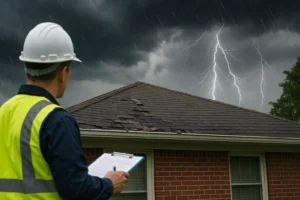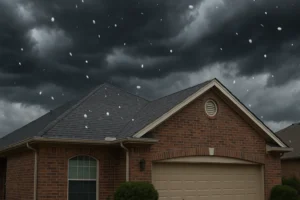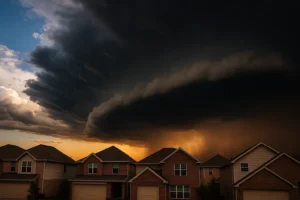If you’ve lived in North Texas for any length of time, you know weather here doesn’t mess around. One day it’s sunny and calm — the next, you’re watching marble-sized hail slam against your windows. That’s the reality of Peak Weather Season in Dallas, a time of year when the city’s mix of heat, humidity, and Gulf moisture creates a perfect storm (literally) for high winds, hail, and lightning.
Let’s ground this in numbers for context:
- Since March 1, 2025, Texas has logged 1,194 hail reports of at least 1-inch diameter.
- On September 8, 2025, a single hailstorm affected 3,701 properties, with more than 1,600 homes hit by stones over 2.5″.
- In Dallas County, there were five hail reports within 10 miles of the city center this year — the largest measuring 1.75″.
- Historically, Dallas County has experienced over 630 hail events, ranking it among the highest-risk regions in the U.S.
That’s not background noise. That’s a pattern every property owner should pay attention to.
Dallas’s Weather Calendar: The Rhythms of Risk
Dallas weather isn’t static; it moves in predictable rhythms. Winter is mostly mild. Summer bakes the ground. But between those bookends — spring and early summer — everything happens at once.
| Season | Typical Conditions | Primary Risks |
| January–February | Cool, dry | Freeze, minor hail |
| March–June | Warm, humid, stormy | Hail, tornadoes, flash flooding |
| July–August | Hot, stable | Heat stress, drought |
| October–November | Transitional storms | Secondary hail/wind events |
| December | Mild chill | Minimal risk |
The Peak Weather Season in Dallas runs from March through June, with April and May being especially active. A smaller “echo” season hits again in October–November when cold fronts clash with lingering humidity.
Why Peak Weather Season in Dallas Is Getting More Intense
The storms aren’t just frequent — they’re growing stronger. Meteorologists point to warmer surface air and more energy in the atmosphere, which translates to bigger hail cores and stronger updrafts.
Dallas’s tornado corridor proximity amplifies that risk. Tornadoes don’t respect city boundaries, and the surrounding counties often bear the brunt of rotating supercells that form along I-35.
In 2025 alone, there were multiple hail events exceeding 2.5 inches, damaging thousands of rooftops and vehicles. For homeowners, that means one thing: your property will, at some point, be tested.
The Real Impact on Property Owners
When Peak Weather Season in Dallas hits, the results are visible — and expensive. Storm-related losses account for some of the most common insurance claims across the metroplex.
Typical damage patterns include:
- Shingles cracked or bruised by hail
- Siding punctured or stripped away by high winds
- HVAC condenser coils dented beyond repair
- Roof leaks developing weeks after the initial impact
- Gutters ripped off by debris or heavy runoff
Even small hailstones can shorten a roof’s lifespan by years. That’s why it’s critical to act before and after peak season — not during the chaos in between.
Preparing Your Property Before Peak Weather Season Hits
Think of preparation as insurance for your insurance. The earlier you start, the fewer surprises you’ll face when the next cell rolls through.
Here’s a five-step checklist to get you ready for the Peak Weather Season in Dallas:
- Inspect Your Roof Early
- Hire a professional roofer or inspector before spring.
- Look for cracked shingles, lifted flashing, or weakened valleys.
- Secure Outdoor Items
- Anchor patio furniture and grills.
- Trim tree limbs hanging over the roof or driveway.
- Check Drainage and Gutters
- Clear out leaves and debris to prevent overflow or fascia damage.
- Document Everything
- Take date-stamped photos of your roof, siding, and interior ceilings.
- These become invaluable when filing an insurance claim later.
- Review Your Insurance Policy
- Know your wind/hail deductible (often 1%–2% of dwelling value).
- Confirm whether your policy includes or excludes cosmetic roof damage.
Pro tip: schedule a pre-season appraisal or inspection — this gives you a documented baseline of your property’s value and condition before storm damage can complicate things.
How an Insurance Appraiser Helps During Peak Season
When the Peak Weather Season in Dallas arrives, so does the wave of insurance claims. And with it, the waiting lines, paperwork, and sometimes — disputes.
This is where insurance appraisers step in. They act as neutral third-party experts who assess the actual damage value and help resolve disagreements between policyholders and insurers.
Here’s what that process can look like:
| Step | What Happens | Why It Matters |
| 1. Inspection | The appraiser reviews roof, structure, and exterior | Ensures no damage is overlooked |
| 2. Report Creation | Photos, measurements, cost breakdown | Provides a professional record |
| 3. Valuation | Replacement-cost estimation | Supports accurate claim settlement |
| 4. Negotiation Support | Appraiser vs. insurer comparison | Keeps claim resolution objective |
During the busiest months — April through June — these professionals can mean the difference between a fair payout and a frustrating delay.
Timing Is Everything: Why Spring Is the Sweet Spot
If you schedule maintenance or inspections before Peak Weather Season in Dallas, you win on two fronts:
- Faster Response Time: Contractors and appraisers have lighter workloads in late winter.
- Better Coverage Confidence: You can address small issues before they become uncovered claims.
Insurance carriers often restrict new coverage changes during active storm months. So, reviewing your policy in February or early March ensures you’re not stuck mid-season with outdated terms.
Common Losses During Peak Weather Season
Understanding what typically goes wrong helps you prioritize what to protect.
| Type of Loss | Cause | Coverage Notes |
| Hail Impact | Roof, siding, vehicles | Usually covered under wind/hail endorsement |
| Tornado/Windstorm | Uprooted trees, roof loss | May trigger separate deductible |
| Lightning Strike | Electrical surge or fire | Standard policy inclusion |
| Flash Flood | Rising water | Needs NFIP or private flood policy |
| Freeze Damage | Burst pipes after cold front | Covered only if preventive steps taken |
Each event carries its own risks, but hail remains the top culprit. And when hail strikes, you’ll need proof — proof that your damage is real, recent, and properly valued.
That’s where Dallas insurance appraisers earn their keep. They provide expert reports on roofing systems, mechanical damage, and structural compromise, ensuring you’re not short-changed when it counts most.
What Businesses Should Know
Commercial properties in Dallas face the same exposure — but with higher stakes. Flat roofs, HVAC units, signage, and skylights make businesses particularly vulnerable.
Actionable steps for property managers:
- Keep vendor contracts for emergency repairs on standby.
- Request a business interruption review to understand downtime coverage.
- Maintain digital inventory and photos of key equipment.
- Coordinate with your appraiser before filing large-loss claims — it saves weeks of back-and-forth later.
Beyond the Storm: Why the Off-Season Matters Too
Once the last storm rolls out, don’t switch off your vigilance. Summer and early fall are prime times to assess what survived and what didn’t.
By booking an off-season appraisal, you:
- Establish post-storm baselines for next year.
- Identify hidden or progressive damage (like minor leaks).
- Gain leverage for renegotiating insurance coverage.
It’s quieter, less stressful, and typically cheaper to secure inspections in July than in May.
Final Thoughts: Take Dallas Weather Seriously — But Strategically
The Peak Weather Season in Dallas isn’t something to fear — it’s something to plan for. Every year, thousands of property owners face storm losses, but those who prepare early and document often come out ahead.
So, before the next thunderhead builds over the Trinity River:
- Walk your property.
- Take those photos.
- Review your coverage.
- And call in the professionals who know how to protect your investment when the wind starts to howl.
Because in Dallas, weather is inevitable — but disaster doesn’t have to be.
Ready to protect your property before the next hailstorm?
Connect with our experts at Dallas Insurance Appraisers to schedule your pre-season consultation and ensure you’re fully covered before the next peak season begins.
Frequently Asked Questions (FAQs)
Peak weather season in Dallas typically runs from March through June, with April and May seeing the most severe storms.
Hail, high winds, lightning, and occasional tornadoes are the most frequent hazards.
Dallas sits in a convergence zone where warm Gulf air meets cooler plains air, fueling hail-producing thunderstorms.
Inspect roofs, trim trees, secure outdoor items, and review your insurance policy before storms hit.
Yes, most policies include wind/hail coverage, but deductibles and exclusions vary — always double-check.
Yes — a pre-season appraisal documents your property’s condition and helps with accurate post-storm claims.
Dallas averages several hail events annually, with hailstones often reaching 1–2.5 inches in diameter.
April and May are historically the peak tornado months, coinciding with the region’s strongest storm systems.
They provide independent damage assessments to ensure fair claim settlements with your insurance provider.
Late winter — before Peak Weather Season in Dallas — ensures your policy is current and effective when storms hit.






